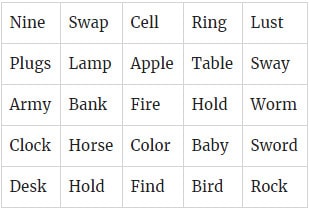NBA
An NBA Statistics Treatise

Humans are naturally confident creatures, and nowhere does this confidence spill over into borderline lunacy more plainly than in the certainty we place on our memories. The average person is vastly overconfident about the capabilities of their memory, particularly their short-term memory; research suggests that we can only remember five to nine individual pieces of short-term information at one time, and more recent studies even suggest the number is likely on the lower end of that estimation.
Want some proof? Here’s a popular short-term memory experiment. Get a timer, and time yourself looking at the list of words found below for exactly two minutes. Then reset your timer, close your computer or phone and give yourself another two minutes to write down as many words from the list as you can.
If you got over 10, you’re either lying or a pretty special case. The average storage capacity for short-term memory items is seven plus or minus two items, per researcher George A. Miller, even for tests like this where the exam was immediate and circumstances were generally favorable for the memory.
That’s just the tip of the iceberg when it comes to both short-term and long-term memory. Several incredibly strong forces work against memory on a regular basis, from emotional attachments and biases to simple realities about the way the chemical parts of the brain change over time.
Did you know that in a 2015 study, over 70 percent of people were able to be convinced, using specific interview techniques, that they had committed a crime that had actually never happened? That’s right, nearly three out of four people admitted to a crime they didn’t commit after nothing more than a few simple techniques applied by interviewers.
The world of sports offers several great examples of the problems with human memory. The use of stats is chief among them – and in particular, the number of folks who still claim a staunch opposition to them.
Sports stats are, in their simplest form, a shorthand for all the relevant things that happened in a given game. Some of them are more descriptive and useful shorthands than others: True Shooting percentage and effective field goal percentage tell us more about shooter quality than standard field goal percentage because they incorporate the separate value of events like free throws and three-pointers, for instance. On some level, though, every stat you see is a compressed, aggregated way of describing something that happened on the court.
“I don’t need that stuff, though,” says that friend we all have, pompously dismissing the very notion that their brain might need an assist from time to time. “I’ve watched basketball for (insert number of years), that tells me everything I need to know.”
The problem is, there’s incontrovertible evidence that it doesn’t.
For starters, look at the facts about short-term memory we just went over. If the brain struggles to even reach 10 individual items that can be accurately stored by the short-term memory, how on earth could it be expected to properly store – and easily recall – the thousands upon thousands of important data points that define the game of basketball?
We’re not just talking about short-term memory here, either. The psychological term “transience” describes an effect that takes place during the storage phase for long-term memories. During transience, memories deteriorate from their original specific qualities into more general memories. That seems pretty relevant when talking about the kind of specific events that define basketball, doesn’t it?
All this is without discussing maybe the biggest threat to accurate memory, one that’s almost universally present in sports: Bias, and the emotion that comes from it.
We all have our biases, many of the subconscious nature that our brains hide from us. In a published study guide, a group of Harvard professors described the way, at times, “what people remember from their pasts says less about what actually happened than about what they think, feel, or believe now.” Other research has shown that the emotional intensity of events significantly impacts the strength of memories – things we show a strong emotional reaction to are more likely to be prioritized by the brain when creating memory.
Sports are, of course, emotional by nature for nearly all their observers, even many of the ostensibly less biased ones. Combine that with the limits of our short-term memories, the weakening of many long-term memories over time and the tendencies our memories have to outright trick us, and you can see why simply trusting them to be accurate about all the factors it takes to properly evaluate basketball is a fool’s errand.
That’s where statistics come in: As a way to catalogue what we see and counter the forces that distort what we remember. And while they certainly aren’t perfect, they’re a hell of a lot more objective than our memories.
* * * * * *
Stats are also easy to access, but not everyone knows that – or how to properly take advantage.
The world of web-based NBA statistics databases requires some time to learn how to navigate, and many of the best metrics and methods out there don’t exactly come with beginner’s manuals. A simple lack of knowledge about where to find basic, relatable ways to digest statistics is undoubtedly a big contributor to the hesitance many feel about attaching importance to them, especially when it comes to big algorithms and probabilistic models with intimidating acronyms for names.
This piece is meant as one small attempt to bridge part of that gap. What follows is a collection of many of the best publicly available online resources for NBA statistics, models, tools and other minutiae.
We’ve attempted to provide a relatively comprehensive look at the features of each site, without being overbearing to the point of absurdity. With apologies to many individuals who post fantastic numerical work on a variety of personal sites or blogs, we’ve stuck to many of the more comprehensive sites currently out there. A few additional notes:
- This list isn’t necessarily in any particular order, though the two largest and most well-used sites are listed first.
- A * next to a given feature denotes a particularly interesting, useful or unique element. A ** denotes a completely unique (within the public sphere), highly useful feature.
- This list will be revised and updated over time. Comments and suggestions for updates can be sent to @Ben_Dowsett on Twitter.
* * * * * *
Table of Contents:
NBAWowy.com
Inpredictable.com
NBAMath.com
NBAMiner.com
* * * * * *
Stats.NBA.com (@nbastats)
Overview:
One of the most indispensable statistical resources available online, the league’s official stat site is rivaled in pure scope only by basketball-reference.com. It contains numerous excellent stats that can’t be found anywhere else, including SportVU and Synergy Sports data. Its video and filtering capabilities are second to none, and completely unique in many areas.
Features:
- Comprehensive list of player and team statistics, including traditional, advanced, usage, scoring profiles, clutch statistics, opponent statistics, shooting statistics (including shot charts) and more.
- *Video: Numerous stats link directly to video clips showing the accumulation of the stat in question. Watch every three-point attempt the Warriors took last year, or view every rebound the Celtics collected – all with a single click (note: at times, certain individual clips will not be available due to glitches or the simple size of the database).
- **Player Tracking: Derived from SportVU camera data, and visible in both listed forms and under individual player/team dashboards. Includes (but not limited to) pull-up/catch-and-shoot, touch/time of possession data, defensive figures (including rim protection % allowed), driving efficiency, passing tracking (potential assists, secondary assists, etc), rebounding.
- **Play Type data: Derived from Synergy Sports, this includes player and team data for specific play types such as pick-and-roll (handler and roll man), post-up, isolation, hand-off, spot-up, transition, etc.
- On/Off Court data: Available for each team, this represents team stats while a given player is on or off the court. Available for traditional, advanced, Four Factors, scoring, opponent and miscellaneous stats.
- *“Hustle” stats: Available at both team and player level, and includes stats like deflections, screen assists, loose balls recovered, charges drawn and shots contested.
- Lineup data: Available by team or league-wide, and for any number of players – from 2-man lineups to 5-man lineups. Available for all typical stat types (traditional, advanced, opponent, scoring, miscellaneous, etc).
- **Impact: Newer tool similar in nature to NBAwowy.com. Allows user to select 1-5 players from any team, then compare that player/lineup’s stats while a second set of 1-5 players (from any team, including the same one as the first selection – that is, the second set can be either teammates or opponents) is either on or off the court. A little complex at first, but one of the most powerful and useful tools anywhere for analyzing matchups and success of teammates with/without each other.
- Box scores: Most consider the league site’s box scores to be among the best out there, particularly those on the media site (discussed in Notes and Cautions below).
- Draft & Combine: Includes draft history and combine data (shooting, strength/agility, anthropology) all the way back to 1947.
- League and franchise leaders in all traditional stats.
Notes and Cautions:
- Perhaps the most impressive and robust element of NBA.com’s stats database is the filtering capabilities. Virtually every page above can be filtered in an incredibly detailed manner, allowing searchers to weed out bits of noise they don’t want to see. No other public NBA stats site comes close to these filtering capabilities. Look for these filters in tabs at the top of a given page.
- Many pages or stats can be accessed in multiple ways via NBA.com’s database. If you’re ever in doubt, follow the basic steps of the sandwich bar in the top left – or for quicker searches, just use the search tab in the top right.
- NBA.com is regularly adding new features to their databases, often in the early fall before a new season begins. Keep an eye out (this article will also be updated as new additions are made).
- Many stats can be viewed in different rate formats – per game, per-36-minutes, per-100-possessions, etc.
- Disclaimer: While those who use it regularly tend to get used to it, some NBA.com users report that parts of the interface are tough to use. Many who are searching for basic stats report that they prefer to use basketball-reference.com, which most report is much more user-friendly. However, for certain kinds of stats (SportVU, Hustle, Play Type, Impact) and for video, these options are not available elsewhere. Also, while basketball-reference.com does offer certain filtering capabilities, they don’t hold a candle to the league site in that department.
- Writers and media members: NBA.com also operates a media site that contains a Media Stats Site. Many of the stats here are duplicates of the regular site, but there are certain differences (one example: the media stats site has the best live box scores on the web for games that are currently running). A login is required for this site, but these have typically not been difficult to procure.
Basketball-Reference.com (@bball_ref)
Overview:
The primary competition for the league site and perhaps the most-visited NBA stats site on the web, basketball-reference.com is an incredibly deep wealth of data. It lacks the filterability and video links of NBA.com along with certain proprietary stats like SportVU, but also contains several unique tools that can’t be found on the league site. Many also report that it’s far more user-friendly than the league site, an important factor for beginners, and does a better job of explaining the stats it houses. These two are the juggernauts of public NBA stats online.
Features:
- The simplest, most easy-to-access database of player, team, season, draft, standings and historical statistics. No site is easier to navigate or understand while providing so much data.
- Player pages: Featuring base stats for every season played (per game, totals, per-36-mins, per-100-possessions, advanced), both regular season and playoffs. Also includes shooting splits, play-by-play stats (positional playing time estimates based on height, plus/minus, turnover/foul details, and miscellaneous data), similarity scores, college stats, leaderboards/awards/honors, transactions and salary data. Sub-links include game logs by year, stat splits, shooting splits, lineup data, on/off court data and more.
- Team pages (by season): Including roster, record, coach/executives/staff, team/opponent stats (per game, totals, per-36-mins, per-100-possessions, advanced), shooting breakdowns, salaries and draft rights. Sub-links include team clubhouse (last 10 games, four factors, calendar), franchise index (lists basic info for all seasons in franchise history), schedule & results, transactions.
- *Seasons pages: Includes standings, team/opponent stats, awards, playoff series info, Player of the Week/Month winners, league leaders by stat categories. Sub-links include schedule and results, player stats, team ratings (including adjusted net ratings, a valuable and underutilized tool), playoff summaries and more.
- Leaders pages: Contains current leaders in numerous basic and advanced stats, for both regular season and playoffs. Also contains historical records for both NBA and ABA.
- Scores page: All daily scores, plus standings on that date. Best resource available for checking past standings.
- *Playoffs pages: Year-by-year playoff breakdowns, including series, stats, leaders and more.
- *Draft pages: Year-by-year draft breakdowns, franchise draft history and expansion draft documentation. Yearly breakdowns include links to view all players picked from a particular school, in a particular draft slot or by a particular franchise.
- **Play Index: An incredibly powerful, useful tool for all forms of basketball research. Includes player game/season/streak finders, team season/game/streak/score/rivalry finders, draft finder, head to head matchup finder (between players), player comparison finder (up to 6 players at once). Also includes play-by-play data searches, including event finder, lineup finder, shot finder and plus/minus finder. All player and team pages also contain links to the finder for that specific team. The Play Index is one of the most widely used tools among popular NBA writers and online personalities. Perfect for looking up an incredibly wide range of historical events that fit certain thresholds, with numerous filtering capabilities.
- Coach Directory: List of all NBA and ABA coaches through history.
- Awards and Honors Index
- NBA Contracts Summary Page: Easy to use, though less detailed and sometimes less accurate than other top salary sites, namely Eric Pincus’ Basketball Insiders database – the best on the web, bar none.
- All-Star Game stats and history
- Frivolities: Fun trivia like birthdates, milestone watch, Hall-of-Fame candidates, “On This Date” and many others.
- NBA and ABA Executives Directory
- NBA Referees Directory
- D-League (now G-League), European, WNBA and Olympic stats
- Glossary: A useful list of all stats with explanations, including formulas for many.
Notes and Cautions:
- Ease of use: Most consider basketball-reference.com to be the easiest to navigate of the bigger statistical databases. A huge percentage of writers and fans alike surveyed for this story indicated they prefer bballref’s navigation and functionality over NBA.com.
- If NBA.com’s most unique and distinguishing factor is their overall filterability, then bballref’s is their Play Index. It rivals the filterability of NBA.com’s overall site, and does so for an incredible wealth of information. No amount of space here could adequately describe all the options available within this tool – trial and error is the best way to learn it. Prepare to go down some serious rabbit holes.
- *Vital disclaimer*: Possessions are calculated differently between NBA.com and basketball-reference.com. This article from Nylon Calculus explains the details of the differences for those interested. This means that several possession-based statistics – offensive and defensive ratings, pace, several rate statistics and many others – will not be calculated in the same ways between these sites. In certain cases, the discrepancies will be quite large. Analysts comparing these sorts of stats between sites must take special care here.
- *Vital disclaimer, part 2*: For stats like offensive rating, defensive rating and net rating, basketball-reference.com houses multiple variations that do not represent the same thing. The key differentiator here is whether you’re looking at team ratings or player ratings. For teams, these stats will represent the same thing you’d find at NBA.com (though again, with different possession calculations and therefore different final results): The points scored, allowed or netted per-100-possessions. Player ratings, however, refer to a much more complex “points produced” model derived by statistician Dean Oliver. These individual ratings do not represent the team’s rating while that player was on or off the court – those can be found in the On/Off tab for a given player page. It’s far too common for casual fans and even experienced writers to confuse these statistics, so take great care.
- Highlighting: For any given stats page or game log, combining multiple years or games into a single clump is easy: Simply click once on the start of the range you wish to view, and then again at the end of it – the site will create a new window tabulating the averages over that period of time. For instance, to easily find LeBron James’ cumulative per-game stats from the 2011-12 season through the 2015-16 season, one would simply go to his player page, click anywhere inside his 2011-12 stats row under “Per Game,” and then click anywhere inside his 2015-16 stats row. It will create a box that looks like this.
- Search tab: The search tab on bballref is quite helpful, and relatively intuitive. You can simply type the first letter of a player’s first name, then begin typing their last name – it will recognize this, among other shorthand.
CleaningTheGlass.com (@cleantheglass)
Overview:
The most recent to launch of any site in this database, Cleaning the Glass is the brainchild of Ben Falk, former VP of Basketball Strategy with the 76ers and Analytics Manager with the Blazers. It began as a public site featuring Ben’s articles and certain other features, and has morphed into a low-priced, subscription-based service that includes in-depth articles, a discussion board and, most importantly for this database, a detailed stats housing site. The stats, which are pulled using play-by-play data primarily, aim to provide more context and functional usability than others on the web. They’re organized in more organic ways based on how modern thinkers understand the NBA game, and great effort is taken to ensure that users understand both the process behind the stats and the areas in which they’re useful. While CTG technically isn’t “public” due to its subscription basis, it’s a very manageable yearly cost and is sure to be a staple of high-level analysis moving forward. It’s well worth a few bucks a month.
Features (not linked due to paywall feature of site):
- A database of intelligent, contextualized statistics organized in ways designed to be more useful to the user. Stats are given in raw number form, but also with percentiles or rankings that help compare and contextualize. Other convenient areas include positional designations (Point, Wing, Big, Combo, Forward rather than traditional 1-5 alignments), splitting of per-possession stats into halfcourt/putbacks and transition, elimination of “garbage time” minutes that often skew numbers, and more.
- *League stats (by team): Includes four factors (eFG%, TOV%, ORB%, FT Rate), shooting stats (frequency and accuracy for both offensive and defensive shooting areas – rim, short midrange, long midrange, all midrange, corner 3, non-corner 3, all 3s), and play context (halfcourt/putback and transition stats for both offense and defense – including frequency, points/poss and points added compared to average).
- *Team stats by player: Includes offensive overview (usage, points per shot, assist percentage, assist-to-usage ratio, turnover percentage), overall shooting (basics plus assisted figures from various areas), shooting frequency (percentage of shot attempts from various areas), shooting accuracy by various areas, foul drawing (includes shooting fouls, floor fouls, and-one percentage), and defense & rebounding (includes a split of rebounds into free throws versus field goals).
- *Team stats overall: Includes team efficiency and four factors (both offense and defense), shooting numbers (frequency and accuracy by area), play context, shooting defense, and defensive play context.
- *Player stats overview pages: Includes offense overview, shot chart (for shot frequency), shooting numbers (overall, frequency, accuracy), foul drawing, defense & rebounding.
- *Player on/off pages: Includes team efficiency and four factors stats, team shooting stats (frequency, accuracy), team context stats (halfcourt/putbacks and transition), opponent shooting (frequency, accuracy), opponent context stats (halfcourt/putbacks and transition).
- **Box scores: Detailed in-game stats that update live. Featuring both raw stats and percentiles/ranks for player/team stats. Includes four factors, shooting (frequency, accuracy, totals by area), team context stats (halfcourt/putbacks and transition), player stats (usage, points per shot attempt, assist %, turnover %, rebounding stats, more).
- Search tab that covers all sections of the stats database.
- Subscribers also get access to weekly articles from one of the best minds in basketball media today, along with access to a discussion board that is being cultivated as a much more intelligent area for basketball conversation that you’d normally find.
Notes and Cautions:
- As noted above, Cleaning the Glass is a subscription site. Yearly plans are available for as little as $50, with multiple options available.
- Cleaning the Glass is all about displaying stats in the most useful and presentable way possible. On top of the rankings and percentiles noted above, many of the stats are slightly tweaked or altered versions of what you might find elsewhere – the goal here is to make them more directly actionable, and the site does a fantastic job of this.
- Continuing that theme, a ton of effort is put in to give detailed explanations of stats and pages. Virtually every page has its own link to an exhaustive breakdown of what its stats mean and how they’re tabulated, and nearly all individual stats have hover-able options that offer a brief description of the number.
- This is still only the beginning for CTG, which only launched in this subscription form recently. It’s likely additional elements will be added moving forward – we’ll do our best to update this section as this happens.
NBAwowy.com (@nbawowy)
Overview:
NBAwowy.com took the stats world by storm a few years ago when it was first introduced, representing a completely new tool. The ability to plug in players either on or off the court for a given team, then view player and team stats during those minutes, is incredibly valuable. The league site has caught up to certain parts of this, as we note further down, but many of the stats on nbawowy are fully unique and virtually impossible to find anywhere else. *Important note: As of the beginning of the season, nbawowy founder Evan Zamir is encouraging users to use the league site whenever possible rather than nbawowy. The volume of use may limit functionality, and Zamir has always lost money on the site while operating it completely on his own.
Features:
- The ability to pick a team, then view detailed team and player stats given any combination of players on or off the floor for that team.
- Filters: Search filters include date ranges, regular season/postseason/preseason, home/road, opponent filter, quarter/overtime filter, minimum possessions.
- *Detail: Derived from play-by-play scraping, queries on nbawowy.com return a wide range of detailed, often unique stats. Sections include shooting, metrics, team/opponent, fantasy, free throws, release, distance, action, prior event, ball handling, rebounding, fouls, defense and units (lineups). There are too many individual stats to list here, but many are play-by-play derivations that are very hard to find in other public spheres. Prior event, action, release, team, opponent and shooting tabs in particular contain several stats you won’t find elsewhere.
- Fantasy: Many have reported that the fantasy tools on nbawowy are very useful for DFS play.
- Labeling: The site does a great job of labeling stats, since there are quite a few.
Notes and Cautions:
- *Important note*: As listed above, the site’s founder is encouraging users to find other options as his functionality may be suffering.
- The same vital disclaimer we saw in our last section regarding possession calculation applies here as well. To my knowledge (appreciate corrections if this isn’t right), nbawowy uses actual possession totals from play-by-play, meaning possession-related stats will be different from both NBA.com and basketball-reference.com.
- In some areas, including in the broadest senses, NBA.com’s addition of the Impact tool rendered parts of nbawowy no longer unique. For people looking to match possession calculation formats with other stats on the league site, this could diminish nbawowy’s usefulness. However, as noted above, many of the stats found on nbawowy are not part of NBA.com’s Impact tool (just as vice versa, certain elements of the Impact tool, particularly the ability to view stats for opponents on or off the court and not just teammates, are not available on nbawowy).
Inpredictable.com (@inpredict)
Overview:
Inpredictable.com is a clear candidate for most under-appreciated stats site on the NBA web. It’s known by most analytics writers and some hardcore fans, but not enough people overall spend time on it. From win probability data to excellent per possession stats that can’t be found elsewhere, inpredictable is wholly unique. It’s also quick to update and very good about transparency with stats and metrics.
Features:
- **Win probabilities: During the season, inpredictable keeps live win probabilities for NBA games. These include margin, time filters, excitement index (how far win probability “traveled” over the course of the game), comeback factor (for the eventual winning team, this is their lowest odds of winning at any point in the game) and individual player stats ranging from free throw and True Shooting percentage all the way to standard and clutch win probability added. With this tool, you can pinpoint the moment your favorite team was a 99.1 percent favorite to win a game they somehow ended up losing. Fun!
- *Per possession statistics: A valuable tool that lists each team’s average seconds per possession and average points per possession for possessions following certain prior events: After a made shot by the opponent, after a turnover by the opponent or after a defensive rebound (totals for all possession types combined are also included). Filters include year, regular season/playoffs, dates and, most importantly, offense or defense – this allows the user to differentiate between offensive and defensive versions of “pace.” This can be far more descriptive than the general “pace” metric found on multiple sites, which only counts overall possessions and does not differentiate between offense and defense.
- Graphs and box scores: Includes completed win probability models for games, and also includes other graphs and charts, including game time, four factors, pace and others. Uses an easy drop-down menu to search any game from any season in the data set.
- *Clutch shooting reports: Breaks down shots into four categories: Normal, clutch (shots with an elevated impact on win probability), clutch-squared (shots crucial to game outcome, such as buzzer-beaters) and garbage time (shots taken when win probability impact is close to zero). Each player is then listed with their total shot attempts in each category, percentage of their shots that fall into each category, and their effective field-goal percentage for each category. Can be filtered by season, position, team, regular season/playoffs, date, 2pt/3pt, and can even be changed to show percentage of team shots instead of percentage of player shots.
- *Player free throw shooting motion: An incredibly cool tool that uses SportVU camera data to visualize the free-throw motion of any player. Contains basic profile view, overhead view, year-by-year changes, comparisons with other players, and a top-20 list for stats like longest windup, biggest year-to-year change and others. Also includes player free throw scatter plots. In all honesty, this tool probably isn’t that practically useful in most cases – it’s just awesome.
- *Player win probability added: Rankings for various different win probability models, including normal, clutch time and garbage time. Also includes the impact individual stats had on win probability. Filterable by season, position, team, regular season/playoffs, date, total/per game.
- *Win probability calculator: Allows the user to type in the quarter, the time remaining, the score difference and whether or not the team had possession. With these figures, the tool spits out an average win probability for the team in that exact situation.
- Team scoreboard: A month-by-month list of all games for a given team, featuring metrics like excitement factor, tension index, comeback factor, offensive and defensive pace and others.
- Team summary: Team profile including areas like excitement index, comeback factor and various win probability metrics for both offense and defense.
- Top games finder: Ranks top games for a given date range based on excitement, tension, comeback, MVP performance and LVP performance.
- Daily NBA rankings: Betting market rankings and stats for several leagues, including NBA and WNBA.
Notes and Cautions:
- Along with basketball-reference.com, inpredictable and creator Mike Beuoy are some of the best on the web when it comes to explaining their stats. Each major page has a link to a detailed explanation of the methodology used, and each stat on a given page can be hovered over to view a brief explanation. The site also contains several related articles and deep dives on similar topics.
- For nerds and junkies out there, it doesn’t get much cooler than this site. It’s honestly a little surprising Beuoy hasn’t been scooped up by a big-money site or a team.
ESPN.com NBA Stats (@espn)
Overview:
Full, honest disclosure: Given the size of the site, the reader base and the resources available, ESPN’s NBA stats are almost offensively bad and limited. Their base stats hold nothing you can’t find much more easily on bballref or the league site, and their only saving grace is found in a few specific advanced stats that ESPN people (current or former) either pioneered or housed there. Frankly, ESPN’s NBA stats are a real disappointment for a worldwide leader. For this article, the only features we will list for ESPN will be those that are at least somewhat unique.
Features:
- *Real Plus-Minus: Based on a combination of play-by-play data and box score statistics, RPM is ESPN’s iteration of the advanced plus-minus world. It’s available starting from the 2013-14 season, though the methodology changed after that initial season so there are really only three seasons with standardized methodology. RPM attempts to quantify player impact while controlling for variables like teammates and opponent players on the court with them. It results in an offensive, defensive and total figure, plus a conversion to “RPM Wins.” Some in the statistical community have reservations about RPM: Its calculation methods are strangely shrouded in mystery, and every year we see a few clear examples of big misses from the metric. It should also never be used as outright rankings. However, with the proper context and grains of salt, it’s useful as a representation of the kind of value a player provides on both sides of the ball, ostensibly independent of some of the noise found in other plus-minus metrics.
- Attendance: Team attendance figures by year.
- Relative Power Index (RPI): A formula that rates teams based on record and strength of schedule. ESPN also does a Basketball Power Index (BPI), along with related BPI playoff odds.
- Trade machine: A tool that allows users to plug in trades and see if they work under the NBA’s CBA. However, there are imperfections here due to the complexities of the CBA.
Notes and Cautions:
- Filtering capabilities for ESPN’s stats are extremely limited, and virtually nonexistent in many areas.
- Many of the base stats are expressed only in per-game formats, with no option to view a different rate. This lags well behind modern basketball understanding.
- It’s not technically part of their stats pages, but their standings pages contain an expanded standings view that has a few elements that can be tough to find in other places (particularly record vs .500 and above and record vs .500 and below).
FiveThirtyEight.com (@FiveThirtyEight)
Overview:
Nate Silver’s brainchild is about far more than just the NBA, and in fact far more than just sports – and yet, what amounts to a few side projects for NBA stats nearly rival the combined efforts of their entire parent site, ESPN. FiveThirtyEight is generally focused on the predictive element when it comes to NBA stats, from season projections to playoff odds and related elements. While you’re there, obviously don’t forget to stop in for excellent data-driven content.
Features:
- *Player projections: Using a system called CARMELO, this is a tool that allows users to plug in any player and view detailed preseason projections. Includes vitals, scoring, tendencies, passing, defense/rebounding, 10 similar players, and some advanced plus/minus data. Projection models are updated each year.
- Team-by-team forecast: Based on that same CARMELO metric and also including a related element based on the Elo ratings system (found in chess and other games), this is a preseason simulation of all 30 teams’ seasons. It gives projected record, projected point differential, playoff odds, top seed odds and title odds.
- In-season projections: Once the season begins, the team-by-team forecast turns into regularly updated projections based on all the same metrics. It gives all the same projections as the team-by-team forecast.
- Daily projections: Once the season begins, FiveThirtyEight continuously posts game odds and projections for each day’s slate of games.
Notes and Cautions:
- From a pure stat-housing standpoint, FiveThirtyEight is relatively narrow in scope, and they’re mostly listed here due to their proximity to ESPN. But their staff is some of the most talented out there, and their metrics are unique and backed by strong empirical research.
NBAMath.com (@NBA_Math)
Overview:
Relatively new on the scene over the last couple years, NBAMath is a site based around a few unique metrics meant to assess broad player value. It has a few really cool tools that aren’t found anywhere else, and is maintained by strong statistical minds. The site does a good job of showing its work, and also has a viable blog pumping out good content even through the slower summer months.
Features:
- *TPA database: NBAMath’s Total Points Added (explained here) is their bread and butter, broken down into offensive points added and defensive points saved. The database holds current TPA statistics for 2016-17 (NBA, D-League and NCAA), plus historic TPA: Individual seasons and playoffs since 1973, year-by-year scores for every player, career standings and full NCAA individual seasons since 2011.
- Playoff stats: Contains player scores and “ring shares” for individual playoffs and for career postseason play. Also contains the same for WNBA.
- *Team stats: Explained here, this model adjusts all teams through history for their era. Gives adjusted overall team ratings (Ortg, Drtg, NetRtg), plus gives era-adjusted scores for various offensive and defensive metrics. Team ratings date back to 1951, while offensive and defensive metric adjustments date back to 1974.
- Rolling team ratings: Using the same adjustments as for team stats, this tool allows the user to plug in a date range for a team and view their 20-game schedule-adjusted rolling team rating.
- *NBA play-type profiles: Derived from NBA.com’s Synergy Sports play type data, this is an excellent tool that allows for the comparison of any two players across multiple offensive and defensive areas. Stats can be sorted by NBAMath’s preferred “value added” stat (difference between player’s PPP and league average PPP for that play type), or by possessions, frequency, points per possession and percentile. The database also contains an interactive list of the entire league’s value added for all offensive and defensive play types. It’s a great, more detailed extension of the play type data on the league site.
- *FATS calculator: Another lovely little tool that can be used for analyzing everything from team performance to individual player on/off expectations. By plugging in certain team and opponent four factors stats easily found on NBA.com, users can be shown a win projection – what a team with those exact stats should be expecting in the win-loss column historically. Because those four factors stats are available at the team, player on/off and even lineup level, though, the applications here are far-reaching. You can compare a team’s actual record to what it “should” be based on the calculator, to see if they’re overachieving. You can compare a given team’s stats while a certain player is on or off the court – per this model, the Cavaliers were a 56-win team with LeBron James on the court last season and just a 28-win team while he sat. You can even look at the expected performance of a given lineup using their four factors data. In addition, the model spits out the top five team matches through history based on these stats. A tad complex at first, but a lot of fun.
- Three-year peaks: Gives a three-year peak based on TPA score for all players dating back to 1973-74. Some dudes named Jordan and James are at the top.
Notes and Cautions:
- NBAMath does a great job explaining their stats, including mostly hover-able stats and a solid glossary.
- NBAMath also contains an in-depth blog meant to find ways to tell statistical stories.
- The site’s Twitter account (linked above in their title) is very active, and tweets a number of interesting charts and visualizations based on their stats.
NBAMiner.com (@NBA_Miner)
Overview:
NBAMiner is one of several sites that are great for little minutiae that you often can’t find in too many other places. Some of their data is relatively straightforward, but other parts are very unique and perfect for NBA trivia. Their Twitter account has been mostly quiet for the summer, but has sent a few responses indicating their stats should continue to update for the 2017-18 season.
Features:
- *Team stats: Includes three sections, with four subsections for each: General (advanced stats, four factors, basic stats, rare stats), Scoring (misc. points, shot types, shot distances, margins & comebacks) and Details (player tracking, turnover details, assist details, foul details). Some of these sections don’t contain much unique stuff, but several others – namely rare stats, margins & comebacks and basically everything under the Details section – have plenty of data it’s tough to find in other places.
- *Player stats: Broken into four sections, each with five subsections: General (basic stats, basic stats per-36, clutch time stats, advanced stats, nasty stats), Scoring (scoring runs, misc. points, shot types, shot distances, shot zones), Details (4points & and1s, player tracking, foul details, assist details, turnover details), and Noteworthy Performances (40+ point games, 20+ rebound games, 15+ assist games, 6+ block games, 6+ steal games). Again, certain sections are relatively standard, while others contain stats you may not have even thought of.
- Predictions: During the season, the site lists predictions for games each day.
Notes and Cautions:
- NBAMiner also has a blog, though it hasn’t been in use since early in the 2016-17 season.
- NBAMiner is another site that does a great job of explaining metrics. There is a full glossary, and all stats can be hovered over for brief explanations.
RealGM.com (@RealGM)
Overview:
In many ways, RealGM.com’s NBA stats site – despite lacking the resources or overall scope – is exactly what you’d expect from a giant like ESPN. There’s nothing too crazy, but the time has been taken to post a few more relevant filters and basic areas that the general NBA fan wants to know. RealGM isn’t the first stop for most deep research projects, but it has great basic information in several important areas plus a few unique pages.
Features:
- A solid-if-unspectacular basic stat layout, featuring both team and player stats in traditional, per-minute, miscellaneous and advanced stat areas. Comes with a nice, simple filtering bar at the top, with solid splits options. Also contains top games, top seasons and daily leaders. Preseason and summer league stats are included, which is a nice perk.
- Depth charts: Intelligently managed, quickly updated depth charts for all 30 teams. Includes starters, rotation and limited playing time designations.
- *GM resources: An excellent, detailed list of numerous executive-related resources. Contains detailed free agency trackers and stats, salary cap info, transaction lists, team staff information, agent-client lists and numerous other tools. List is located in a drop-down menu at the top right of RealGM’s NBA section.
- Trade checker: Similar to ESPN’s Trade Machine, though with fewer glitches to this eye.
Notes and Cautions:
- RealGM also has great analysis from several good writers, plus one of the better NBA forums active online.
- The site also has similar stat databases for NCAA, G League, international play and even high school play.
Honorable Mentions
A few sites that absolutely deserve mention here, but didn’t quite make our final list:
- Statmuse.com: A site that gripped the states community for a few days when it first launched a beta, Statmuse allows users to type in stat questions in a query format before spitting out an answer. It’s incredibly novel and the creators have done a great job fine-tuning the capabilities, but for most researchers or fans who spend lots of time on stats, it takes longer to learn the query shorthand and figure out which kinds of stats it houses and doesn’t house than it does to simply look these things up from their original outlets. It also doesn’t pull quite the variety of stats one might hope for.
- DraftExpress.com: Most of the stats DraftExpress has posted over the years – combine measurements, mock rankings and basic stats, for the most part – aren’t completely unique, but the site itself has been so excellent that it deserves mention. Things will be changing now that its primary managers, Jonathan Givony and Mike Schmitz, have been hired by ESPN to lead their draft coverage – DraftExpress will only exist in archive form moving forward. It’ll be interesting to see what kind of statistical developments Givony and Schmitz bring to ESPN.
- NBASavant.com: This site makes the list for posterity’s sake alone – for a period of time, it may have been the most indispensable stats site on the web for NBA junkies, even including the two big giants. NBASavant creator Daren Willman brought us an incredibly detailed way to search and filter SportVU stats from NBA.com, particularly for things like defender distance (contested shots versus uncontested, etc). It also had NBA.com’s video element attached, and also had a dozen other tools derived from play-by-play, SportVU or other scrapable sources online – things like shot chart comparisons, foul leaderboards, team schedule maps and all sorts of other fun resources. Unfortunately, two events combined to render it mostly defunct: Firstly, the league removed certain web services that allowed for NBASavant to pull the proper SportVU shot and defender distance data, ruining its most valuable quality. Secondly, Willman was hired as the Director of Baseball Research and Development for Major League Baseball after another site of his, baseballsavant.com, was noticed for its incredible quality. NBASavant only has a few stats left that are regularly updated, and it’s tough to even trust these given that they’re likely running on automated scripts, not anything Willman is actively updating.
- 82Games.com: A cool site that houses a few fun stats and does some interesting deep dives, 82Games just lacks too much around the margins to be a consistent resource. The interface is not easy to use, and there are some strange statistical definitions and boundaries. On top of that, there really isn’t anything particularly unique that you can’t find elsewhere.












